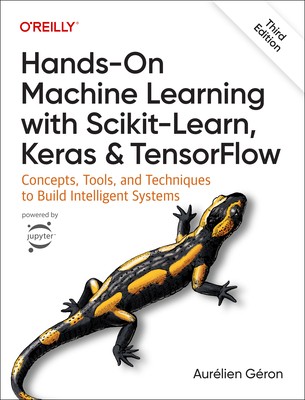
- We will send in 10–14 business days.
- Author: Géron
- Publisher: O'Reilly Media
- ISBN-10: 1098125975
- ISBN-13: 9781098125974
- Format: 17.8 x 23.3 x 4.3 cm, minkšti viršeliai
- Language: English
- SAVE -10% with code: EXTRA
Hands-On Machine Learning with Scikit-Learn, Keras, and Tensorflow (e-book) (used book) | bookbook.eu
Reviews
Description
Through a recent series of breakthroughs, deep learning has boosted the entire field of machine learning. Now, even programmers who know close to nothing about this technology can use simple, efficient tools to implement programs capable of learning from data. This bestselling book uses concrete examples, minimal theory, and production-ready Python frameworks (Scikit-Learn, Keras, and TensorFlow) to help you gain an intuitive understanding of the concepts and tools for building intelligent systems.
With this updated third edition, author Aurélien Géron explores a range of techniques, starting with simple linear regression and progressing to deep neural networks. Numerous code examples and exercises throughout the book help you apply what you've learned. Programming experience is all you need to get started.
- Use Scikit-learn to track an example ML project end to end
- Explore several models, including support vector machines, decision trees, random forests, and ensemble methods
- Exploit unsupervised learning techniques such as dimensionality reduction, clustering, and anomaly detection
- Dive into neural net architectures, including convolutional nets, recurrent nets, generative adversarial networks, autoencoders, diffusion models, and transformers
- Use TensorFlow and Keras to build and train neural nets for computer vision, natural language processing, generative models, and deep reinforcement learning
EXTRA 10 % discount with code: EXTRA
The promotion ends in 23d.23:19:11
The discount code is valid when purchasing from 10 €. Discounts do not stack.
- Author: Géron
- Publisher: O'Reilly Media
- ISBN-10: 1098125975
- ISBN-13: 9781098125974
- Format: 17.8 x 23.3 x 4.3 cm, minkšti viršeliai
- Language: English English
Through a recent series of breakthroughs, deep learning has boosted the entire field of machine learning. Now, even programmers who know close to nothing about this technology can use simple, efficient tools to implement programs capable of learning from data. This bestselling book uses concrete examples, minimal theory, and production-ready Python frameworks (Scikit-Learn, Keras, and TensorFlow) to help you gain an intuitive understanding of the concepts and tools for building intelligent systems.
With this updated third edition, author Aurélien Géron explores a range of techniques, starting with simple linear regression and progressing to deep neural networks. Numerous code examples and exercises throughout the book help you apply what you've learned. Programming experience is all you need to get started.
- Use Scikit-learn to track an example ML project end to end
- Explore several models, including support vector machines, decision trees, random forests, and ensemble methods
- Exploit unsupervised learning techniques such as dimensionality reduction, clustering, and anomaly detection
- Dive into neural net architectures, including convolutional nets, recurrent nets, generative adversarial networks, autoencoders, diffusion models, and transformers
- Use TensorFlow and Keras to build and train neural nets for computer vision, natural language processing, generative models, and deep reinforcement learning


Reviews